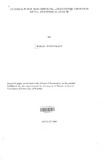| dc.description.abstract | A group of low-income countries have continueci to ex-petience c1ifflcu\tiesin m.ana-s'm-s and servicing their relatively huge stocks of external debt. Most of these countries, including Kenya are in Sub Saharan Africa. The relatively high level of Kenya's external indebtedness, rising debt burden and inability to source sufficient external finance at favourable terms and conditions has serious implications on the country's economic performance.
This study examined the relationship between Kenya's external indebtness, debt service and her economic growth. To pursue this objective, the study used a single growth equation model estimated using Ordinary least Square (OLS) method with annual time series data covering the period 1970 - 2003.
The findings of the study indicated that Kenya's external debt is mainly official, of which a bigger proportion is from multilateral sources. External debt accumulation has been
rising over the years with debt burden indicators increasing steadily in the early 1990s.A
"
specification associated with error correction modeling (ECM) was applied. By using
cointegration and error correction model, the study established both the shOli run and long run equilibrium. The estimated model was a single regression equation with the growth rate of Gross Domestic Product as the dependent variable and explanatory variables were savings as-a ratio of GDP, stock of external debt as a ratio of GDP, debt service as a ratio of GDP, interest payment as a ratio of GDP and the annual growth rate of labour force.
The empirical results in the short run estimated model indicated that the coefficients of external debt to GDP, savings to GDP and debt service to GDP had the correct sign and significant while the coefficients of interest to GDP and growth in labour force were insignificant. In the long run estimated model, the coefficients of debt to GDP, debt serviceto GDP and savings to GDP were significant while the coefficient for growth in labour force and interest to GDP were insignificant. The main result of interest was the
--
\,11
coefficient of the external debt service ratio, which was negative and statistically significant at 5 percent level. This result showed that there was a negative relationship between GDP growth rate and external debt servicing.
The study concluded that removing the external debt constraint would not only be good for growth, but also it could directly make resources available which would foster economic growth in Kenya. Policy makers should therefore consider coming up with sound policies that will ensure that all financial inflows in the country in the form of debt
or aid is effectively and productively utilized. | en |

